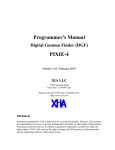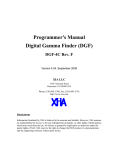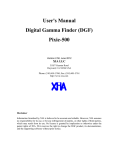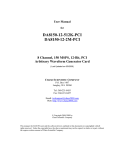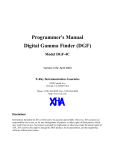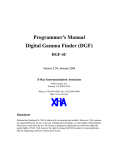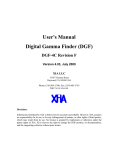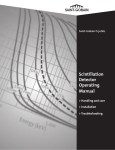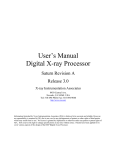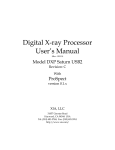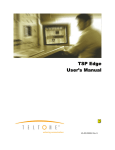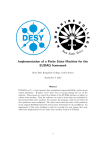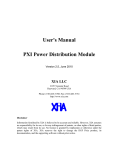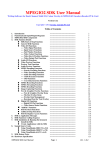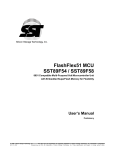Download What`s New in PIXIE Viewer Revision 2.63 (February 2014) What`s
Transcript
What’s New in PIXIE Viewer Revision 2.63 (February 2014) General: – Added new user function call in main Igor code: User_HomePaths(). This is used to specify customized DSP and parameter files for customized application, e.g. SAUNA, PhosWatch, PSA automatically at the initial setup. UserVersion is updated to 0x103. Existing Igor User code (modifications in User.ipf) are no longer compatible with release 2.63. However, code will work with old User.ipf files unless the UseHomePaths() macro is executed or bootfiles are not found. To update a customized User.ipf, copy the function User_HomePaths() from the file User.ipf in this distribution. PSA Pixie-500: – – – Updated PSA manual with description of Pixie Viewer analysis utilities Updated User_PSA.ipf with User_HomePaths() and removed PSA_Bootfiles function. copied checkbox for breaking run into multiple files to User Control panel PhosWatch Pixie-4: – – – – – – Modified beta energy calibration routine Updated default settings for PPW201and added calibration file for PHD write Corrected spectrum reads from IMS files (space, not tabs) Updated User_PW.ipf with User_HomePaths() fixed minor bugs in creation of phd file added PSM parameter description to Programmer's manual SAUNA Pixie-4: – – – – – Incorporated and tested latest User file from FOI recompiled DSP code to latest version Updated User_SAUNA.ipf with User_HomePaths(), change default DSP files to latest (was _402) minor tweaks in appearance of SAUNA panel modify IMS read to not expect tabs for 1D spectra What’s New in PIXIE Viewer Revision 2.62 (January 2014) PhosWatch Pixie-4: – – – – – – Fixed bug in DSP code corrupting LM files Modified averaging reoutine for gain stabilization Created default settings and macro for PPW201 Updated default settings and macro for PW101 Fixed bug in Igor energy calibration routines Updated PW manual (type 17 events = vetoed LED pulses) PSA Pixie-500: – add timestamp and channel number to PSA table – – set first 4 values of waveforms to NAN for all channels Updated PSA manual What’s New in PIXIE Viewer Revision 2.60/2.61 (October 2013) Code Changes: – – – – – – Fixed bug in accessing settings files in offline mode Fixed bug and added time stamp in.dt3 text files Added ZDT and online PSA option in P500 firmware (FPGA) Fixed bugs in DSP PSA computations Added Igor functions to plot PSA outputs Created custom “technician” interface What’s New in PIXIE-4 Viewer Revision 2.52-55 (Spring/Summer 2013) – – – – – – – – Recompiled DLL for LabView Recompiled MPI variant Added a number of new User Channel variables for PMT gain stabilization Added list mode processing into dt3 and dt4 text files Added option to globally suppress events with one channel going out of range (low) Fix bug in time scale of oscilloscope during refresh Clarify live time counter description: factor 2 in OCR(ICR) not always correct Clarified use of runtask 7007, 7008 in programmer's manual What’s New in PIXIE-4 Viewer Revision 2.51 (Released July 2012) This is a release of the Pixie Viewer supporting Pixie-4 Rev. E modules. Pixie-4 Rev. E modules are feature and code compatible with previous hardware versions when using release 2.43 or higher. The following minor differences exist for Rev. E: – lead free/RoHS production – SMA front panel connectors extend slightly further for better cable connections – additional connections to backplane lines (for custom applications) – revised power suplpy for lower noise – analog signal conditioning section has been updated with high speed relays to minimize distortion for very fast signals (e.g. plastic scintillator or LaBr3 without integrating preamplifier). This has the following side effects: - there no longer is an audible click when changing gains - very fast signals may appear with larger amplitude and faster rise times. It is advised to verify that gain and energy filter settings used with Rev. C/D modules in applications with such signals still apply correctly to Rev. E modules. – to protect the circuitry and to shield the high speed relays from noise, an optional EMI cover can be added to the main components side. This cover can be removed by the end user to change clock and input termination jumpers Note: This release uses PLX drivers 6.50. Please refer to the readme file for instructions to upgrade drivers. Code Changes: C library - Fixed a bug in list mode file processing function which creates .dat file. Fixed a bug in MaxEvents computation. Added list mode file processing function template for users code 0x7010. What’s New in PIXIE-4 Viewer Revision 2.50 (Released July 2012) This is a release of the Pixie Viewer supporting Pixie-4 Rev. E modules. Pixie-4 Rev. E modules are feature and code compatible with previous hardware versions when using release 2.43 or higher. The following minor differences exist for Rev. E: – lead free/RoHS production – SMA front panel connectors extend slightly further for better cable connections – additional connections to backplane lines (for custom applications) – analog signal conditioning section has been updated with high speed relays to minimize distortion for very fast signals (e.g. plastic scintillator or LaBr3 without integrating preamplifier). This has the following side effects: - there no longer is an audible click when changing gains - very fast signals may appear with larger amplitude and faster rise times. It is advised to verify that gain and energy filter settings used with Rev. C/D modules in applications with such signals still apply correctly to Rev. E modules. – to protect the circuitry and to shield the high speed relays from noise, an EMI cover is added to the main components side. This cover can be removed by the end user to change clock and input termination jumpers Note: This release uses PLX drivers 6.50. Please refer to the readme file for instructions to upgrade drivers. Code Changes: General - - Revised coincidence logic. The common coincidence window for all channels still applies, but each channel can be delayed individually before starting the window. This is useful to accommodate shorter cables or shorter energy filters for one or more channel and allows to center the coincidence window at an arbitrary time difference between channels (no longer only at zero). The smallest possible coincidence window has been decreased to 40ns. Consequently, the “minimum coincidence wait” is no longer enforced. See descriptions of KEEP_CW, MIN_COINCIDENCE_WAIT, COINCDELAY, RESETDELAY in the Programmer's manual for details Added flags to list mode output data to indicate pileup, out of range, VETO or GATE occurred. Stored in channel header word USER_PSA unless overwritten by user DSP code. (Pixie-4 only at this time). ( USER_PSA bits 3|2|1|0 = Gate | Pileup | Out of range | Veto) All Pixie-500 timers now have the option to operate at the filter processing rate. That means if selected, timestamps are now in units of 2ns (2.5ns for 400 MHz version) for buffer time, event time and channel trigger time. Smallest increment of timestamps is 8ns (10ns for 400 MHz version). MODCSRA bit 10 controls this option (if bit 10 = 1, timestamps are in 2/2.5ns units) Igor - Fixed bug in ADC filter plot: Threshold now indicated correctly for Pixie-500 C library - Fixed bug in runtask 0x7004-0x7006 that returned data in wrong output format (main use is in phoswich variant) DSP, Firmware - Connected VETO signal in Pixie-500 firmware A trigger threshold of 0 disables trigger, now also in Pixie-500 What’s New in PIXIE-4 Viewer Revision 2.45 (Released June 2012) This is a release of the Pixie Viewer supporting Pixie-4 Rev. E modules. Pixie-4 Rev. E modules are feature and code compatible with previous hardware versions when using release 2.43 or higher. The following minor differences exist for Rev. E: – lead free/RoHS production – SMA front panel connectors extend slightly further for better cable connections – additional connections to backplane lines (for custom applications) – analog signal conditioning section has been updated with high speed relays to minimize distortion for very fast signals (e.g. plastic scintillator or LaBr3 without integrating preamplifier). This has the following side effects: - there no longer is an audible click when changing gains - very fast signals may appear with larger amplitude and faster rise times. It is advised to verify that gain and energy filter settings used with Rev. C/D modules in applications with such signals still apply correctly to Rev. E modules. – to protect the circuitry and to shield the high speed relays from noise, an EMI cover is added to the main components side. This cover can be removed by the end user to change clock and input termination jumpers Note: This release uses PLX drivers 6.50. Please refer to the readme file for instructions to upgrade drivers. Code Changes: NEC variant - Fixed bug in relay isotope specific out-of-range flag in NEC firmware PhosWatch variant - Tested version 2.4x. No code change from last release Standard variant - No code change from last release What’s New in PIXIE-4 Viewer Revision 2.44 (Released May 2012) This is a release of the Pixie Viewer supporting Pixie-4 Rev. E modules. Pixie-4 Rev. E modules are feature and code compatible with previous hardware versions when using release 2.43 or higher. The following minor differences exist for Rev. E: – lead free/RoHS production – SMA front panel connectors extend slightly further for better cable connections – additional connections to backplane lines (for custom applications) – analog signal conditioning section has been updated with high speed relays to minimize distortion for very fast signals (e.g. plastic scintillator or LaBr3 without integrating preamplifier). This has the following side effects: - there no longer is an audible click when changing gains - very fast signals may appear with larger amplitude and faster rise times. It is advised to verify that gain and energy filter settings used with Rev. C/D modules in applications with such signals still apply correctly to Rev. E modules. – to protect the circuitry and to shield the high speed relays from noise, an EMI cover is added to the main components side. This cover can be removed by the end user to change clock and input termination jumpers Code Changes: NEC variant - Fixed bug in relay setting for Rev. E module in NEC firmware Implemented isotope specific out-of-range flag in NEC firmware Changed clearing of AUX counter in NEC firmware Inverted use of ModCSRA bit 8 in NEC firmware Updated NEC documentation What’s New in PIXIE-4 Viewer Revision 2.43 (Released April 2012) This is the first general release of the Pixie Viewer to support Pixie-4 Rev. E modules. Pixie-4 Rev. E modules are feature and code compatible with previous hardware versions. The following minor differences exist for Rev. E: – lead free/RoHS production – SMA front panel connectors extend slightly further for better cable connections – additional connections to backplane lines (for custom applications) – analog signal conditioning section has been updated with high speed relays to minimize distortion for very fast signals (e.g. plastic scintillator or LaBr3 without integrating preamplifier). This has the following side effects: - there no longer is an audible click when changing gains - very fast signals may appear with larger amplitude and faster rise times. It is advised to verify that gain and energy filter settings used with Rev. C/D modules in applications with such signals still apply correctly to Rev. E modules. – to protect the circuitry and to shield the high speed relays from noise, an EMI cover is added to the main components side. This cover can be removed by the end user to change clock and input termination jumpers Code Changes: General - Updated Variants for custom applications DSP, Firmware - Fixed bug in relay setting for Rev. E module. Fixed bug in waveform capture Fixed bug in “current ICR” measurement What’s New in PIXIE-4 Viewer Revision 2.40 (Released Jan. 2012) Code Changes: C library - Added support to read versions and serial numbers of Pixie-4 Rev. E and Pixie-500 Rev. C modules Added xop and driver files using PLX version 6.3.1 for compatibility with Windows 2000. See readme file in drivers folder for details Updated xop project to Visual Studio 2005. Includes updating libraries and headers to XopToolkit Version 5. - Fixed bug causing occasional error in offline booting mode DSP, Firmware - Added option to average 4 ADC samples per waveform sample, i.e. store 4x longer traces at ¼ the sampling rate. This option is experimental and not necessarily available in the future. What’s New in PIXIE-4 Viewer Revision 2.32 (Released Jan. 2012) Code Changes: Igor, C library, DSP - Added new variable names used in a special application Added controltask for triggered ADC trace capture Revised usage and description of “hand down names” function What’s New in PIXIE-4 Viewer Revision 2.31 (Released Jan. 2012) Code Changes: C library - Updated PLX drivers to version 6.5 for better compatibility with Windows 7 Windows 2000 (and earlier) is no longer supported What’s New in PIXIE-4 Viewer Revision 2.30 (Released Oct. 2011) Code Changes: DSP code and Firmware - Revised GDT counters to be active even when run is stopped (in “gate statistics” mode) Revised buffer header time stamps (now kept in FPGA) Make event and channel time stamp pointers available to DSP user code C library - Update PLX drivers to version 6.4.2 for better compatibility with Windows 7 Revised list mode processing run tasks 0x700x to be more efficient Improved support for Linux compilation. Includes moving of compiler options and environment variables into makefiles and Visual Studio project files and global variable name definitions (defs.h) Broke up sample.c into dedicated programs for booting, acquisition, etc. Debugged 16/16 double buffer mode readout. Emwords no longer cleared to indicate which block to read! Igor - Revised histogram binning for PhosWatch variant ROOT - Developed sample interface. (Available on request) Manual - Added software interface manual for LabView Minor updates and clarifications Bug Fixes: - C library: Added check for bad boot patterns - Firmware: Debugged polling problem What’s New in PIXIE-4 Viewer Revision 2.20 (Released Jan 28, 2011) Code Changes: DSP code and Firmware - Added logic to accept external trigger on front panel to System FPGA Added option to send Hit of Channel 3 to STATUS line. Setting trigger threshold to zero switched off trigger generation Added “gate run statistics” option to count live time and rates only when Gate/Veto are on and gate time GDT independent of live. Added polarity option for GDT Added option to latch status of gate inputs instead of pulsed/delayed gate signals. C library - Changed controltasks 0x4 and 0x3 into controltasks 0x84 and 0x83 as they are C -library tasks (0x4and 0x3 are automatically converted to 0x84 and 0x83 for backward compatibility) Changed “Find_Tau” from User_Par_IO arguments to controltask 0x81. Old tau finder calls from old user interface will not work with new C library! Removed “Update_Filterrange_Params” as User_Par_IO argument, now done automatically after changing filterrange Igor - Added new controls for above code changes Revised calls to controltasks 0x3, 0x4, to “Find_Tau” and “Update_Filterrange_Params” for above changes Added default settings for new PhosWatch detectors Manual - Updated Programmer and User Manual for above code changes Updated online help for above code changes Added 14bit, 400 MHz variant to Pixie-500 User Manual and to Programmer Manual Updated description of double buffer readout in Programmer Manual Added section on list mode time stamps to User Manual Bug Fixes: - Firmware: Fixed bug in advanced pileup options (disable, invert) DSP: Fixed bug causing one count in bin 2059 of the spectrum at runstart Firmware: Fixed bug in Pixie-500 group trigger logic causing false coincidences Firmware: Fixed bug in Pixie-500 FIFO logic causing badly captured waveforms Firmware: Fixed bug in Pixie-500 timestamp logic causing inconsistent timestamps C library: Fixed bug in Compute_Maxevents – event buffer length is actually 4060 words What’s New in PIXIE Viewer Revision 2.16 (Released Dec. 6, 2010) This is a specific release for the Pixie-4 PhosWatch software. Changes: PhosWatch Code and Manuals – files: added default settings files for PW101-102 – Igor: Added control panel for basic (spectra only) acquisition – Igor: Updated generation of IMS PHD files – Igor Added control panel for energy calibration – manual: revised manual and added new sections on energy calibration and basic setup/operation General Code – None What’s New in PIXIE Viewer Revision 2.15 (Released Oct. 20, 2010) This is a general release for Pixie-4 and Pixie-500 modules. Major changes since the last general release (2.02) include: (2.10) Upgraded PLX PCI drivers to version 6.3 to allow operation under Windows 7 / 64 bit (2.11) Added support for the Pixie-500 (2.12) Added support for the 400 MHz variant of the Pixie-500 (2.12) Updated LabView GUI to accommodate the time scale from Pixie-500 and Pixie-400 (2.14) C library: Fixed bug that caused list mode file parsing to crash in some cases (2.14) Igor: Fixed broken link from “Start Scan” button in optimize tau and optimize filter panels (2.14) Firmware: Fixed bug in group trigger distribution (2.15) Firmware: Fixed bug in gain setting logic, causing gain relays to switch other than expected For details and description of bug fixes in previous releases please see below Note: This firmware (DSP, Fippi, System) is NOT compatible with previous versions. What’s New in PIXIE Viewer Revision 2.14 (Released Oct. 12, 2010) - C library: Fixed bug that caused list mode file parsing to crash in some cases - Igor: Fixed broken link from “Start Scan” button in optimize tau and optimize filter panels - Firmware: Fixed bug in group trigger distribution Note: This firmware (DSP, Fippi, System) is NOT compatible with previous versions. What’s New in PIXIE Viewer Revision 2.12 (Released Sept. 10, 2010) Added support for the 400 MHz variant of the Pixie-500 Updated the LabView GUI to accommodate the time scale from Pixie-500 and Pixie-400 What’s New in PIXIE Viewer Revision 2.11 (Released July 21, 2010) This is the first general release of the Pixie-500 software Changes: Manuals - Added pictures to description of input jumpers Development still in progress: - C library: remove “Update_Filterrange_Params” and “Find_Tau” as User_Par_IO arguments (update automatically for first and make a C library controltask for second) Update trigger distribution between Pixie-500 modules What’s New in PIXIE-4 Viewer Revision 2.10 (Released June 18, 2010) Code Changes: C library - Fixed bug in double buffer readout introduced in release 2.05 Added support for 500 MHz module “Pixie-500” Upgraded PLX PCI drivers to version 6.3 to allow operation under Windows 7 / 64 bit To upgrade drivers, the following procedure seems to give best results: - In Windows' Device Manager, find the Pixie-4 module under “other devices” (will appear as “PLX Custom (OEM) PCI 9054 Board”) - Double click on the device to open the device property window - Select the “Driver” tap - Click “Update Driver” - Windows will suggest to find drivers using Windows Update: select “NO” and click Next - In the next screen, select “Dont search. I will choose driver” and click Next - In the next screen, select “Have disk” and browse to PLXSDK.inf in the drivers directory of the Pixie-4 software. (If a driver version 6.3.1 is shown, you may select it instead of clicking “”Have disk”) - If Windows complains about unknown/unsigned driver, click “continue anyway” - Verify the device property window shows driver version 6.3.1 Note: In Windows 7, the unsigned driver may prevent completion of the installation. The current workaround is to install the free PLX software development kit, available from http://www.plxtech.com Development still in progress: - C library: Revise code to compile with “optimized” flag C library: remove “Update_Filterrange_Params” and “Find_Tau” as User_Par_IO arguments (update automatically for first and make a C library controltask for second) What’s New in PIXIE-4 Viewer Revision 2.05 (Released Apr 6, 2010) Code Changes: DSP code and Firmware - Revised readout in double buffer mode to reduce the chance of bad data. For an “emergency stop” when both halves of the memory are full, the data is now read out such that the 16 buffer per module structure is maintained (previously there were 32 buffers/module for the stop condition, 16 buffers/module normally ). Revised firmware for trace capture, faster waveform readout Note: This firmware (DSP, Fippi, System) is NOT compatible with previous versions. Settings Files - Added sample NaI and LaBr3 settings files Bug Fixes: - C library: Fixed bug in copying of Filterrange Development still in progress: - C library: Revise code to compile with “optimized” flag C library: remove “Update_Filterrange_Params” and “Find_Tau” as User_Par_IO arguments (update automatically for first and make a C library controltask for second) C library: Add support for 500 MHz module “Pixie-500” What’s New in PIXIE-4 Viewer Revision 2.04 (Released Jan 26, 2010) Code Changes: DSP code - Expanded “integrator” options for energy computation Revised binning for SAUNA variant Development still in progress: - C library: Revise code to compile with “optimized” flag C library: remove “Update_Filterrange_Params” and “Find_Tau” as User_Par_IO arguments (update automatically for first and make a C library controltask for second) DSP/Firmware: increase data readout speed from FPGA FPGA: debug occasional bad traces for very short/very long pre-trigger trace setting What’s New in PIXIE-4 Viewer Revision 2.03 (Released Nov 20, 2009) Bug Fixes: - DSP: Fixed bug in E<0 option DSP, System FPGA: Fixed bugs in memory write, causing MCA problems in some modules. Development still in progress: - C library: Revise code to compile with “optimized” flag C library: remove “Update_Filterrange_Params” and “Find_Tau” as User_Par_IO arguments (update automatically for first and make a C library controltask for second) DSP/Firmware: increase data readout speed from FPGA FPGA: debug occasional bad traces for very short/very long pre-trigger trace setting What’s New in PIXIE-4 Viewer Revision 2.02 (Released Oct 15, 2009) Code Changes: LabView - Updated LabView interface for software version 2 C library - Updated C functions for updated LabView interface DSP code - Decoupled “Estimate E” and “E<0” options (previously “Estimate E” meant E<0 is accepted even if “E<0” not specifically enabled) Manuals - Programmer: Updated description of Pixie_Acquire_Data function and of controltasks Bug Fixes: - Igor: Fixed typo in MCA display fit menu text Igor: Fixed bugs in Gauss Fits (fit limits for spectra scaled in keV, processing file series) Development still in progress: - C library: Revise code to compile with “optimized” flag C library: remove “Update_Filterrange_Params” and “Find_Tau” as User_Par_IO arguments (update automatically for first and make a C library controltask for second) DSP/Firmware: increase data readout speed from FPGA FPGA: debug occasional bad traces for very short/very long pre-trigger trace setting What’s New in Pixie-4 Viewer Revision 2.01 (released August 25, 2009) since Revision 1.63 New features and major changes: • • • • • • • • • • • Revised Igor user interface. - (1.90) Controls now show parameters for all channels of a module - (1.90) Control panels are accessed through a small “MAIN” panel that also repeats the most commonly used action buttons and controls. In particular it is no longer necessary to switch tabs to change a parameter, then start a run - (1.90) Modified scaling and fit options in MCA spectrum panel - (1.90) Added panel and functions to scan through energy filter settings in a series of files - (1.90) Requires at least Igor Pro version 5.0 Revised and improved run statistics - (1.90) Previous “livetime” was ill defined. It counted the time a channel was active (i.e. able to issue triggers) and was stopped for the FPGA readout, but not filter dead time. Now livetime simply counts the time a channel is active, all dead time effects are counted in SFDT for all run types - (1.90) Added SFDT, FTDT and GDT counters to count dead time in slow filter due to pileup inspection and readout, dead time in trigger filter counting input pulses, and the time a channel was gated, respectively. - (1.90) All time counters are measuring “individual” times for a channel, so the (ill defined) channel option was removed - (1.90) Added/Activated NOUT to count output pulses for each channel - (1.90) Added TOTALTIME measuring the time since the DSP received the most recent start run command (in list mode run, start of first spill). This is the best measure of total lab time passed since clicking “start run” button. However, this can not count time lost in host PC for issuing command to DSP, and the clock is only precise to 50ppm, thus may deviate from true lab time - (1.90) Changed format of .ifm file to include new counters and rates (2.01) removed support for Rev. B modules (2.00) Added “Keep_CW” option to handle Coincidence Window minimum requirement: a) as before: increase for req minimum, but never decrease; b) always keep at re. minimum; c) ignore req. minimum. Option selected by Igor (or C system global), applied in C library, not stored in DSP parameters (2.00) Implemented common MCA and list mode histogramming routine; clover histogramming now available in list mode runs also, Emin cutoff also available in MCA runs. (2.00) Modified C library to be better ANSI C compliant or at least easier to replace non-compliant functions (1.90) Updated hardware driver to PLX version 5.2. It is therefore necessary to “update drivers” for each module used, e.g. in Window’s Device Manager. Each slot is considered an independent device and has to be updated individually. New driver files are located in the “drivers” subfolder. (1.90) Increased maximum length of trigger filter to allow lowering threshold in noisy systems (1.90) Revised Gate and Veto functions (adding options to invert and stretch/delay signals) (2.00) revised GATE logic to make selectable the edge (rising/falling ) that starts Gate Window (1.90) The C library now always expects up to 17 modules for its internal functions. This eliminates the need for separate settings files for 8-slot and 18-slot chassis. Loading old 8-slot settings files will generate a warning that the file is incomplete (which can be ignored). When the settings are saved the file will be in the 18-slot format. • • • (1.90) Made baseline parameters BLCUT and BLAVG available for user I/O in the “Advanced” tab. These parameters are useful for fine tuning settings for best energy resolution. (1.90) Removed legacy “fast list mode” run types. If DSP still receives a runstart command with a fast list mode run, it treats it as a standard list mode run. (1.90) Old settings files are slightly incompatible with new settings files due to several changes in variable definition. Parameter MODCSRA CHANCSRA Old Bit 0 controlled local time stamp option in group trigger mode Bit 1 controlled “individual livetime” option Bit 9 was reserved Bit 13 was reserved CHANCSRC FASTADCTHR USERDELAY Unused Unused, likely zero New Bit 0 now ignored Bit 1 now ignored Notes Use CHANCSRA bit 13 instead (for each channel individually) Counters always measure channels independently Bit 9 now is used to allow negative energies as a result of the pulse height computation Bit 13 now is used for local time stamp option in group trigger mode Bit 0-2 control GATE/VETO options. Bits 3-6 control advanced pileup options Must be equal to Trace Delay (in clock cycles) To convert old settings: “load” old settings file into Igor, click into “Trace Delay” control and hit <enter>, then “save”. Complete list of changes: Igor - (2.01) removed support for Rev. B modules (2.01) Added common plots and control panels to top menu bar “XIA” (2.01) Improved appearance of History and FileSeries plots (2.00) Added “Keep_CW” option to handle Coincidence Window minimum requirement in Coincidence tab. (2.00) Renamed Igor internal functions and rearranged them in procedure windows for clarity. User function calls remain unchanged. (2.00) Added checkbox for edge select of Gate Window start to Gate controls (2.00) Added new output variables ICR and OORF for current input count rate and out of range fraction to Oscilloscope (2.00) Updated Igor user code variants with changes introduced in 1.6x (2.00) Added POS spectrum to SAUNA variant, cleaned up control panel (1.90) Revised User Interface. Control panels are accessed through a small “MAIN” panel that also repeats the most commonly used action buttons and controls. Controls now show variables for all channels of a module. (1.90) Revised underlying variable structure: Most display variables are now elements of arrays that are (one-module) copies of the arrays handed down to the C library. Requires at least Igor Pro version 5.0 (1.90) Revised naming of Igor functions and organization of procedure files - (1.90) Added BLCUT and BLAVG as “advanced” user parameters (baseline control for optimizing energy resolution) (1.90) Added panel and functions to scan through filter and tau settings while creating a series of files (1.90) Added panel and function to parse through file series and sum total spectra (1.90) Modified scaling and fit options in MCA display (1.90) Added Run Control options to start and stop at given time/date (1.90) Moved manual tau fit to oscilloscope panel (1.90) Added plot of event rates for each update C library - - (2.00) Introduced checks to avoid division by zero in computations of the rate parameters (2.00) Added “Keep_CW” variable to handle Coincidence Window minimum requirement (2.00) replaced all occurrences of Sleep() with Pixie_Sleep(). Pixie_Sleep() calls Sleep(), so code is still not fully OS independent, but replacement of Sleep() with an equivalent Linux function only has to be made only in Pixie_Sleep() not all throughout the code. (2.00) renamed min, max and round functions to avoid potential conflicts with common C libraries (2.00) Rewrote get_ns_per_cycle() to be ANSI standard. Changed wait_for_a_short_time() to take the argument in nanoseconds and updated its use (2.00) removed unnecessary header file pixie_c.h, reorganized header files and contents (2.00) Updated copy/extract function to include new variables (2.00) Added new output variables CURRENT_ICR and CURRENT_OORF for current input count rate and out of range fraction (1.90) Updated hardware driver to PLX version 5.2 (1.90) Integrated standard pxisys.ini files specifying crate architecture as C library constants and added support for XIA 14-slot 6U chassis. Includes disentanglement of MaxNumModules (defining crate type) and PRESET_MAX_MODULES (defining maximum possible number of modules in system). The latter is now set to 17 independent of the crate used. Thus parameters are always defined for 17 modules (even if not used). When parsing output data, up to 17 modules are expected, independent of the current crate setting, i.e. in data files created with an 18-slot crate, module numbers >7 are recognized even if the current setting is an 8-slot crate. Also removes need for crate-dependent settings files. (1.90) Revised UA_PAR_IO for clarity; all user parameters are now checked for legal limits; UA_PAR_IO and related functions moved to separate file (1.90) Revised computation of minimum coincidence wait to only include “good” channels (1.90) Added function to explicitly recomputed BLCUT for all channels of a module (1.90) Replaced addresses in PCI register I/O with constants defined in defs.h (1.90) Revised automatic determination of BLCUT DSP code changes - (2.01) Added option to use baseline averages instead of short base sum B in Phoswich PSA (2.00) Implemented common MCA and list mode histogramming routine; clover histogramming now available in list mode runs also, Emin cutoff also available in MCA runs. (2.00) Added new output variables ICR and OORF for current input count rate and out of range fraction (2.00) Updated DSP code variants with changes introduced in 1.6x - (2.00) Added POS spectrum to SAUNA variant (1.90) Added user option to allow energies <0 (1.90) Updated default values for input parameters after power up (1.90) Created new user variant (NEC) (1.90) Removed unused DSP parameters (1.90) Revised and improved run statistics (1.90) Changed DSP parameters: Variable MODCSRA Type Module input Description See table above Channel input See table above FASTADCTHR0..3 USERDELAY0..3 Change definition change definition change removed added Channel input GATEWINDOW0..3 added Channel input GATEDELAY0..3 added Channel input TOTALTIMEA..C added Module output AECORR, LECORR ATCORR, LTCORR LIVETIMEA..C0..3 removed removed definition change Module output Module output Channel output OVERFLOWA..B0..3 INSPECA..B0..3 UNDERFLOWA..B0..3 ADCPERDACA..B0..3 FTDTA..C0..3 removed removed removed removed added Channel output Channel output Channel output Channel output Channel output SFDTA..C0..3 GCOUNTA..B0..3 NOUTA..B0..3 GDTA..C0..3 added added added added Channel output Channel output Channel output Channel output Never used Stores “Trace Delay”, the amount of pretrigger waveform. Replaces PAFLENGTH and TRIGERDELAY in firmware operation, however both these parameters still have to be set to legal values for backwards compatibility; Uses address previously used for FASTADCTHR Sets length of GATE coincidence window after rising edge on GATE input Sets additional delay between GATE input and detector input (detector input typically delayed by ~200ns due to ADC and other analog stages) Measures time since last runstart command (first spill in list mode runs). Best measure of total lab time passed since clicking “start run”, but can not account for delays caused by host PC No longer used Never used Previously counted time a channel is active, in List Mode run minus time for FPGA readout. Now simply counts time a channel is active, readout and other effects are counted in SFDT Never used Never used Never used Never used Counts time trigger filter is over threshold and thus can not detect new pulses Counts dead time associated with each pulse Number of pulses on GATE input Number of output counts for this channel Counts time GATE is active (length of GATEWINDOW for each GATE pulse OR VETO being high) CHANCSRA, C Manual - (2.00) Updated list of libraries and headers required for compilation in programmer’s manual (1.90) Updated programmer manual with new user options (1.90) Updated driver readme file (1.90) Added section on run statistics to user manual (1.90, 200) Revised/updated user manual sections on Pixie Viewer, Gate/Veto functions, troubleshooting (1.90, 2.00) Revised/updated online help for new panels and functions Firmware - (2.00) revised GATE logic to make selectable the edge (rising/falling ) that starts Gate Window (1.90) Revised waveform capture logic to reduce dead time (1.90) Added function to module coincidence to synchronize event readout between modules (1.90) Revised and improved run statistics (1.90) Increased maximum length of trigger filter to allow lowering threshold in noisy systems (1.90) Added advanced pileup control options (disable, invert, pause) and option to disable outof-range rejection Bug Fixes: - - (2.01) Igor: removed unused /commented code (2.01) Igor: Fixed function call error from Expert Panel (2.01) Igor: Periodic auto-updates of Run statistics and MCA are now based on time, not spills, even in list mode Run statistics can be enabled for updates without updating MCA (which takes time) (2.01) DSP: fixed bug in computation of TOTALTIME when clocks are synchronized (2.01) DSP: fixed bug causing bad run statistics after ending a run by user stop, timeout, or buffer full condition. (2.01) DSP: fixed bug causing event time stamps to be cleared every run. (2.01) DSP: fixed bug in memory readout in 16/16 buffer mode (2.01) C library: Cleaned up code to reduce compiler warnings and added minor improvements: -- replaced U8 for string variables with S8 (=char) -- made ErrMSG a global variable -- created file “globals.c” for variable definition (incl. parameter names previously defined in parnames.h) -- changed often used variable “index” to “idx” for better Linux compatibility. (2.00) Igor: fixed bug for New Files option with 16/16 buffer mode; run was not stopped when making new files so MCA and run statistics did not reset for each file (cumulating instead over all files in series). Now MCA and run statistics are cleared for each file. (2.00) C library: fixed bug in UA_PAR_IO which would not recognize name ALL_CHANNEL_PARAMETERS (looked for _VARIABLES instead) (2.00) Igor fixed bug that would never let Coincidence Pattern be changed for module number >0 (2.00) Igor: fixed bug in “local time” checkboxes in Trigger tab (1.90) Igor: Corrected computation of offline filters from captured waveforms (1.90) Igor: Fixed possible data path error for tables from expert panel (1.90) C library: Removed typo “;” in some if statements (1.90) DSP: corrected CFD pulse shape analysis to handle differences >32K correctly Development still in progress: - C library: Revise code to compile with “optimized” flag C library: remove “Update_Filterrange_Params” and “Find_Tau” as User_Par_IO arguments (update automatically for first and make a C library controltask for second) DSP/Firmware: increase data readout speed from FPGA FPGA: debug occasional bad traces for very short/very long pre-trigger trace setting What’s New in PIXIE-4 Viewer Revision 1.63 (Released Dec 10, 2008) Changes: DSP code changes - User Code now has option to prevent binning of a channel’s energy into the spectrum and to reject events (all 4 channels) from the list mode output buffer (in compressed run types only) Created new DSP variant for dual spectra from phoswich (rise time discrimination) Updated DSP variant to suppress events (or channel’s waveform capture) based on user defined energy threshold (includes addition to module coincidence function to synchronize event readout between modules) Firmware - Added function to module coincidence to synchronize event readout between modules Igor - Updated application specific user interfaces Manual - Updated programmer manual with new user options Bug Fixes: - DSP: energies computed to greater than 64K are now set to zero (previously rolled over) DSP: fixed bugs in DSP variant computing 2D spectra from phoswich detector signals What’s New in PIXIE-4 Viewer Revision 1.62 (Released Sept 10, 2008) Bug Fixes: - DSP, C library, Igor: Fixed bugs causing corrupted list mode data files (Igor polling improperly, C lib not checking if data is ready, DSP not counting properly in 32x or double buffer mode) What’s New in PIXIE-4 Viewer Revision 1.61 (Released May 6, 2008) Bug Fixes: - Igor: Modified panel controls to be better compatible with Igor version 6.03 (e.g. color of tabs, size of button text) Igor: Separated out the (one) function incompatible with Igor version 4 in a separate procedure window “Version5plus”. This function is optional; if Igor complains about not being able to - - - compile properly at startup of Pixie interface, delete (close and kill) the procedure window. Note: Future versions of Pixie-4 interface may not be compatible with Igor version 4. DSP: fixed bug in interrupt routine for MCA runs that could cause wrong energies or even cause module to not finish run (trying to process presumed remaining events due to pointer error). Would occur especially for short coincidence windows or high count rates when new event is likely while last event not yet fully processed. C library: Fixed incorrect declaration of CSR, WCR variables in “Get_Slow_Trace” function (a test/R&D function used to capture continuous waveforms from ADC) C library: Corrected Boot command in sample.c (from 0x1 to 0x1F) and added note to point out need to change compile option in defs.h when compiling sample.exe rather than Igor xop. Firmware: Restructured and recompiled Fippi firmware, fixing bug in energy sum capture (may have been overwritten during readout), fixing odd behavior for specific values of energy filter times, and fixing spurious fast triggers observed in some modules. Igor: When storing version information on file, module serial number is now written in decimal format (was hex). Manuals: Updated release number to 1.61. Manuals: Removed last table in PDM manual and corrected the stated output count rate for random pulses in module coincidence firmware to ~18,000 counts/s. What’s New in PIXIE-4 Viewer Revision 1.60 (Released on 3/31/2008) since Revision 1.41 New Features: 1. (1.60) Updated PXI-PDM manual 2. (1.60) Added Igor function for multi-file MCA runs without Igor background task to reduce filling up of PC's virtual memory 3. (1.60) verified Igor (version 6) and Pixie-4 software work ok with Windows Vista. Vista’s “transparent” Window frames make Igor look odd, but no problem in performance. 4. (1.56) Revised module coincidence: PXI-PDM in slot 2 can obtain full 48 bit hit pattern from modules in slots 3-14 and make an accept/reject decision specified by user. 5. (1.56) Changed default settings file to depend on “local” coincidence test. Older files (pre-1.55) lack this entry in the MODULEPATTERN variable and thus do never accept events. 6. (1.56) Added function to oscilloscope to capture a pulse (repeating “refresh” until waveforms have variations of more than 100 ADC steps). This is useful to view traces in low count rate applications. 7. (1.56) Report status of front panel input at time of event in list mode data (hit pattern) 8. (1.55) Revised Firmware and DSP code for improved coincidence test. Coincidence test is now applied in FPGA, not DSP, saving processing time and improving accuracy of timing. Integrates better with (revised) module coincidence performed by PXI-PDM in slot 2, but limited coincidence tests can be applied without PDM 9. (1.55) Event time stamps are now latched in FPGA at time of validated trigger, not in DSP after response to interrupt. This reduces jitter compared to channel time stamps (low words are exactly synchronized). Run time and buffer start time are still based on DSP timer. 10. (1.53) Added new code variant (SAUNA), acquiring 2D spectra 11. (1.53) Minor modifications to ensure compatibility with Igor 6. 12. (1.52) Support the correct recognition of Rev. D modules. The only difference in functionality in Rev. D modules is that it announces itself as "Revision = 3", which affects computation of the serial number. In principle Rev. D modules can be operated with release 1.40, if error messages for "revision mismatch" are ignored. 13. (1.50) Use new “unified” DSP code for Pixie-4 and DGF-4C Rev. F (DSP code version 3.50 and higher). 14. (1.50) Added double buffer function for module readout, to let host read out data from one block in external memory while DSP continues to acquire data and write to other block (Rev. C, D only). See programmer’s manual, appendix C for details. Changes: DSP code changes DSP parameters: - added variable SUMDAC, ChanCSRCx, ModCRSC, NoutA/Bx (still unused) - moved variable CHANNUM in DSP memory (to just before U00) - added EMwords2, DblBufCSR for double buffer readout - DSPBUILD encodes the DGF model in upper 4 bits: Pixie-4 = 0x2 - added DECIMATION to output block, a copy of input FILTERRANGE - changed usage of MODCSRA, MODULEPATTERN, NNSHAREPATTERN, CHANCSRA DSP code - RESUME is set to zero at end of run by the DSP. This allows host to resume runs without having to set the variable explicitly, saving some I/O time. User DSP code - made HITPATTERN (= hit pattern of current event) accessible to user code Output data - Buffer header variable BUFFORMAT is now 0x2000 + Runtype (not 0x1000) - HIT Pattern contains additional status information. See user’s manual table 4.4 - Added DSP variable INTEGRATOR to data reported in .ifm file Igor Interface - Modified RUN Tab to better organize controls for list mode runs - Modified Chassis Register Panel for now coincidence function - Modified call to user routines: User_NewFileDuringRun() now called before run is resumed, not after; added User_UpdateMCA(), called after MCA updates. - Minor changes in Oscilloscope panel, List mode trace display, List mode spectrum display - (1.60) Added Igor function for multi-file MCA runs without Igor background task to reduce filling up of PC's virtual memory C library - After changing NNSHAREPATTERN, call ControlTask 5 to apply to FPGA and PDM. - After changing CONINWAIT or COINCPATTERN, call ControlTask 5 to apply to FPGA. - Modified list mode data readout for double buffer mode. Firmware - Modified use of PXI backplane lines - Modified module coincidence logic - Modified time stamps latching - Minor changes in waveform capture and trigger generation Manuals - Updated user and programmer manual for changes described above. Changes in programmer manual are highlighted. Also updated manual for PXI-PDM. Bug Fixes: - Igor: Added function to update DSP version after booting - Igor: Increased maximum binning factor to 8 - DSP: Increased length of intermediate buffer to 4060 (was 2044). This also shifts memory locations of output buffer and user variables in the DSP memory. Use the .lst file to look up DSP memory addresses! - DSP: The ACTIVE bit in the CR is now set with minimal delay after runstart (prev. may take several 100us) - C library: Corrected readout of external memory (waiting for CSR bit 7 to clear). - (1.57) Fixed bug in ControlTasks 3 and 6 where baseline reads from Fippi failed. In ControlTask 3 this was compensated by using ADC values instead. When ControlTask 6 was used to compute BLcut, the C library function would use a default value when baseline reads failed. Thus the effect of this error was usually minimal. What’s New in PIXIE-4 Viewer Revision 1.52 (Released on 7/27/2007) Note: This is a limited release for revision D modules (serial numbers 250 and higher) New Features: 1. This release supports the correct recognition of Rev. D modules. The only difference in functionality in Rev. D modules is that it announces itself as "Revision = 3", which affects computation of the serial number. In principle Rev. D modules can be operated with release 1.40, if error messages for "revision mismatch" are ignored. (But see Known Issues, below) Bug Fixes: 1. Updated online help for channel register panel and chassis register panel, especially the trigger sharing modes 0-3. 2. Increased length of intermediate buffer to 4060 (was 2044). This also shifts memory locations of output buffer and user variables in the DSP memory. Programmers should use the .lst file to look up DSP memory addresses. This modification allows compressed list mode runs to acquire longer traces or more events without rejecting new events, as the intermediate buffer is filled as quickly with events not yet processed into the output buffer. Previously, if the combined trace length was more than 13 microseconds, only one event at a time could be recorded, i.e. the effective dead time for an event was increased by the processing time. Now this limit is 26 microseconds. Known Issues: 1. The double buffer mode introduced in release 1.50 seems to be broken in this release. 2. Specific Rev. D modules may show bit errors in waveforms when used with Fippi FPGA 1A3A from release 1.40. What’s New in PIXIE-4 Viewer Revision 1.50 (Released on 4/30/2007) Note: This is a limited release for initial testing of the “double buffer” function New Features: 1. This release uses the new “unified” DSP code for Pixie-4 and DGF Rev. F (DSP code 3.50). This has the following differences to earlier versions: DSP parameters: - added variable SUMDAC, ChanCSRCx, ModCRSC, NoutA/Bx (still unused) - moved variable CHANNUM in DSP memory (to just before U00) - added EMwords2, DblBufCSR for double buffer readout - DSPBUILDNUMBER encodes the DGF model in upper 4 bits: Pixie-4 = 0x2 For user DSP code, there are the following changes - made HITPATTERN (= hit pattern of current event) accessible to user code For output data, there are the following changes - Buffer header variable BUFFORMAT is now 0x2000 + Runtype (not 0x1000) 2. Added double buffer function for module readout, to let host read out data from one block in external memory while DSP continues to acquire data and write to other block (Rev. C only). See separate document for description Bug Fixes: 1. The ACTIVE bit in the CSR is now set with minimal delay after runstart (previously. may take several 100us) 2. Fixed bug in C library during readout of external memory (waiting for bit 7 to clear). What’s New in PIXIE-4 Viewer Revision 1.41 (Released on 2/16/2007) New Features: 1. Added option to not parse list mode run at end of run. Avoids long wait when taking long files, but need to load files manually to view events 2. Added option of integrator = 3/4/5, acts same as integrator =1, but multiplies energy by factor 2/4/8. 3. Updated manuals with new features Bug Fixes: 3. Fixed bug in module coincidence code 4. Fixed bug in CFD computation for compressed list mode runs What’s New in PIXIE-4 Viewer Revision 1.40 (Released on 12/08/2006) New Features: 1. Added alternative trigger distribution for systems with >7 modules where signals have to cross PXI segment boundaries (no wire-OR possible) 2. Updated description of coincidence window in manual and Igor controls 3. In multi-module systems, all offsets are now adjusted simultaneously in all modules 4. Added user code version tracking variables 5. Added option to estimate energy in channels not reporting a hit (e.g. below trigger threshold or piled up) 6. Added option to latch timestamps based on local trigger only (not distributed trigger as before); this provides time of arrival information for channels without the need for waveform capture 7. Added version tracking register in FPGAs 8. Added description of User_Data for Acquire_Data function in Programmers manual Bug Fixes: 1. Fixed bug in polling Rev. B modules 2. Fixed bug in chassis control panel 3. Fixed bug in capturing waveforms that arrive at different times indifferent channels (within coincidence window) 4. Changed max. PCI bus number to 128 (for complex PCI bus systems) 5. Modified runtask 0x7001 to count also events with hit=0000 6. Added check for BufNData==0 in list mode parsing routines to avoid infinite loop. What’s New in PIXIE-4 Viewer Revision 1.38 (Released on 09/21/2006) This is an intermediate release (limited distribution) on the way to version 1.40 Bug Fixes: 1. Fixed bug in adjusting offsets 2. Fixed bug in setting share pattern for module 1 and above 3. Ensured coincwait limit of ~200ms is not exceeded New Features: 1. Expanded module coincidence function using wire-OR lines. If enabled, the status of 4 module coincidence lines is stored as bits 4-7 in the event hit pattern. 2. The front panel input can contribute to one of the wire-OR lines used in module coincidence test. 3. In long runs, Igor can now break the output data into several files, incrementing run numbers every N spills (or N seconds in MCA runs). This is equivalent to clicking the "Start" button repeatedly. 4. If Igor is set to automatically increment run numbers, it makes an attempt to not overwrite existing files. 5. The panel displaying list mode traces now also shows timestamps and PSA values. List mode data processing uses new routines in the C library (0x7007, 0x7008) for the trace display (instead of 0x7002 and 0x7003). The older routines are still working, but their use is not recommended. 6. Modified filter display for list mode traces and added filter display for ADC traces (for best results, ensure trigger filter time is an integer multiple of the ADC sampling interval) 7. Added user plug-in procedures to Igor code. The main Igor code calls user functions at start run, stop run, etc. The user functions can be customized by the user. A user control panel allows setting of user DSP variables 8. User functions have been customized for several custom applications. 9. Added driver installation section to user manual. What’s New in PIXIE-4 Viewer Revision 1.34 (Released on 03/13/2006) 1. Updated Programmer’s manual to include descriptions about DSP parameters related to setting coincidence between modules. 2. Updated User’s manual. What’s New in PIXIE-4 Viewer Revision 1.33 (Released on 03/03/2006) What's New in the Software Bug Fixes: 3. Fixed bug in updating runtime and output count rate. 4. Fixed bug in saving of list mode data from external memory (32 spills at a time) that caused extra words at end of 32nd buffer when run was manually stopped. 5. Fixed bug for Igor polling time = 0 introduced in Viewer Revision 1.30. What’s New in PIXIE-4 Viewer Revision 1.30 (Released on 01/28/2006) What's New in the Software New Features: 1. A module can now accept/reject events based on result of coincidence test from neighboring module(s). 2. Added new panel showing all run statistics, plus run start/stop time and date. This information can be saved to an .ifm file (if desired, automatically after a run). Run start/stop time are also saved in header of .itx file when saving MCA manually. 3. Run statistics can be updated during run. 4. Made period for auto-update of MCA and statistics selectable. Bug Fixes: 1. Fixed bug in copying parameter Baseline %. 2. Added ModuleCSR as a separate item when copying parameters. 3. Fixed bug in saving of list mode data from external memory (32 spills at a time) that caused extra words at end of 32nd buffer, freezing software when parsing output data. 4. Updated Trigger/Filter FPGA to suppress fast triggers when waiting for readout, which caused occasional wrong timestamps in list mode data due to triggers relatching timestamps. What’s New in PIXIE-4 Viewer Revision 1.23 (Released on 10/04/2005) What's New in the Software 1. Added option to use the MMCX front panel input (labeled DSP-OUT, between channels 1 and 2) as an input for GFLT (Veto) signals. The front panel input signal is distributed over the backplane to all modules; only one module may use this option which is enabled in software. 2. Added support for clover detectors: In MCA runs the DSP can compute the sum of individual channel energies for events with hits in more than one channel and bin it into an addback spectrum. Currently spectrum length is fixed to 16K in this mode. What’s New in PIXIE-4 Viewer Revision 1.22 (Released on 12/03/2004) What's New in the Software 1. Speeded up the system booting. 2. Made storing of list mode .dat file optional on the Data Record Option Panel. Since the .dat is saved as a text file so its size could be much bigger than the .bin file. 3. The software now supports 18-slot PXI chassis. A user can select 4/8 slot chassis or 18slot chassis on the Pixie-4 Start Up Panel. NOTE: for 18-slot chassis, the first module (module #0) must be in the first bus segment, i.e. slots 2 - 6. 4. Resolved a few compatibility issues related to different IGOR PRO versions, mainly IGOR PRO ver. 4 and ver. 5. What’s New in PIXIE-4 Viewer Revision 1.20 (Released on 08/04/2004) Hardware Software revision 3.2.0 also supports the new Pixie-4 hardware revision C. Revision C modules are compatible with Revision B modules, but have the following new features: 1. The module can be PXI clock master if residing in slot 2. 2. The module can disconnect from backplane trigger lines, which allows several trigger groups in one chassis. 3. The module can store list data of several runs in the external memory, which can be read out in a fast burst transfer, reducing read-out dead time. 4. The module has additional connections for optional trigger distribution via front panel or backplane (currently not implemented). 5. The module has a front panel LED to indicate host I/O. Revision B and Revision C modules use different configuration files, which are automatically selected by the software. Note that if both revisions are used together in the same chassis, item 3 is not possible. PIXIE-4 Viewer - IGOR Interface 1. Added a new “Backplane Option” to the Module Register Edit Panel. If set, connect module trigger lines to backplane. Triggers will be shared with other modules. If not set, triggers are distributed only between channels of this module, depending on channel settings. 2. Added a new “Read 32 list data buffers per spill” option to the Data Record Option Panel. This feature is only available in Revision C Pixie-4 modules. Previously (Revision B modules), the host needs to read out the DSP’s internal 8192-word buffer before it can resume the next run. Now, the host can choose to store 32 consecutive 8192-word buffers in DSP’s external memory before it reads out the whole external memory. This will also improve the data transfer speed since the host can directly access the DSP external memory using fast burst transfer. PIXIE-4 API (C Driver) Updated driver to accommodate the new hardware features in Revision C modules. Firmware Updated communication FPGA configurations for Revision C modules. Manuals 1. User’s Manual i. Added descriptions for Revision C clock distribution mode. ii. Added screenshots of Pixie-4 Viewer. iii. Added Pixie-4 functional block diagram. 2. Programmer’s Manual i. Updated the manual to accommodate the new hardware features in Revision C modules. ii. Updated description of MODCSRA. What’s New in PIXIE-4 Viewer Revision 1.10 (Released on 05/28/2004) PIXIE-4 Viewer - IGOR Interface 1. Improved “Offline Analysis” functionality. Without using a Pixie-4 module, a user can still excise the features of the Pixie-4 Viewer, or display previously acquired MCA spectra or list mode data. 2. Added a new functionality for the automatic update of MCA spectra every 5 seconds. It can be enabled by clicking on the option “Update MCA every 5 seconds or spills” on the “Data Record Option Panel” (accessible through “Run” tab -> “Record” button). 3. Added a new “Update” button on the MCA Spectrum panel. A user can click on it to update the MCA spectrum while a MCA or list mode run is in progress. 4. Expanded the functionality of the “Sum” button on the MCA Spectrum panel. Now a user has three options for summing a MCA spectrum: (1) Sum-Background between limits; (2) Sum between limits; (3) Sum complete MCA. 5. Expanded the functionality of the file I/O on the MCA Spectrum panel. Now a user has three options for importing or exporting a MCA spectrum: (1) Save MCA to an Igor text file; (2) Read MCA from an Igor text file; (3) Extract MCA from a MCA binary file. 6. Added a “More/Less” button to the Pixie4 Run Control Panel (next to the “Help” button on the bottom of the Control Panel). It can be used to hide some controls. This may be helpful to those first-time Pixie users who only need to use those major controls in the beginning. PIXIE-4 API (C Driver) This new version of Pixie-4 API is a major overhaul compared to the previous releases in the following aspects: 1. Streamlined the error message relay from the bottom layer of the API to the host computer. The host computer program should check the return value of each of the API functions, and any negative return value indicates an error in the API. Error message information and error handling methods can be found in the Programmer’s Manual. 2. Improved the user parameter I/O function Pixie_User_Par_IO. Now a user parameter is classified as either a “SYSTEM” parameter, or a “MODULE” parameter, or a “CHANNEL” parameter. Please see the Programmer’s Manual for the detailed description of these types of parameters. 3. Module Number and/or Channel Number are now part of the input parameters for functions Pixie_User_Par_IO, Pixie_Acquire_Data and Pixie_Set_Current_ModChan. This will give API programmers more flexibility when using these functions. Firmware No change. Manuals 1. User’s Manual i. Added the jumper settings for different clock distribution modes; ii. Added descriptions for those new controls added to the Igor interface. 2. Programmer’s Manual i. Rewrote Section 2 where each API function is described; ii. Updated the descriptions of DSP variables in Section 4.



































